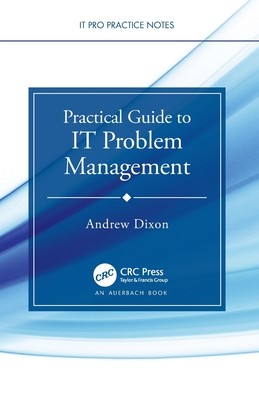
- We will send in 10–14 business days.
- Author: Andrew Dixon
- Publisher: Auerbach Publications
- ISBN-10: 0367636220
- ISBN-13: 9780367636227
- Format: 12.9 x 19.8 x 0.5 cm, softcover
- Language: English
- SAVE -10% with code: EXTRA
Reviews
Description
Some IT organisations seem to expend all their energy firefighting - dealing with incidents as they arise and fixing, or patching over, the breakage. In organisations like this, restarting computers is seen as a standard method to resolve many issues. Perhaps the best way to identify whether an organisation understands problem management is to ask what they do after they have restarted the computer. If restarting the computer fixes the issue, it is very tempting to say that the incident is over and the job is done. Problem management recognises that things do not improve if such an approach is taken. Such organisations are essentially spending their time running to stay in the same place.
Written to help IT organisations move forward, Practical Guide to IT Problem Management presents a combination of methodologies including understanding timelines and failure modes, drill down, 5 whys and divide and conquer. The book also presents an exploration of complexity theory and how automation can assist in the desire to shift left both the complexity of the problem and who can resolve it. The book emphasises that establishing the root cause of a problem is not the end of the process as the resolution options need to be evaluated and then prioritised alongside other improvements. It also explores the role of problem boards and checklists as well as the relationship between problem management and Lean thinking. This practical guide provides both a framework for tackling problems and a toolbox from which to select the right methodology once the type of problem being faced has been identified. In addition to reactive methods, it presents proactive activities designed to reduce the incidence of problems or to reduce their impact and complexity should they arise.
Solving problems is often a combination of common sense and methodologies which may either be learnt the hard way or may be taught. This practical guide shows how to use problem solving tools and to understand how and when to apply them while upskilling IT staff and improving IT problem solving processes.
EXTRA 10 % discount with code: EXTRA
The promotion ends in 20d.11:08:02
The discount code is valid when purchasing from 10 €. Discounts do not stack.
- Author: Andrew Dixon
- Publisher: Auerbach Publications
- ISBN-10: 0367636220
- ISBN-13: 9780367636227
- Format: 12.9 x 19.8 x 0.5 cm, softcover
- Language: English English
Some IT organisations seem to expend all their energy firefighting - dealing with incidents as they arise and fixing, or patching over, the breakage. In organisations like this, restarting computers is seen as a standard method to resolve many issues. Perhaps the best way to identify whether an organisation understands problem management is to ask what they do after they have restarted the computer. If restarting the computer fixes the issue, it is very tempting to say that the incident is over and the job is done. Problem management recognises that things do not improve if such an approach is taken. Such organisations are essentially spending their time running to stay in the same place.
Written to help IT organisations move forward, Practical Guide to IT Problem Management presents a combination of methodologies including understanding timelines and failure modes, drill down, 5 whys and divide and conquer. The book also presents an exploration of complexity theory and how automation can assist in the desire to shift left both the complexity of the problem and who can resolve it. The book emphasises that establishing the root cause of a problem is not the end of the process as the resolution options need to be evaluated and then prioritised alongside other improvements. It also explores the role of problem boards and checklists as well as the relationship between problem management and Lean thinking. This practical guide provides both a framework for tackling problems and a toolbox from which to select the right methodology once the type of problem being faced has been identified. In addition to reactive methods, it presents proactive activities designed to reduce the incidence of problems or to reduce their impact and complexity should they arise.
Solving problems is often a combination of common sense and methodologies which may either be learnt the hard way or may be taught. This practical guide shows how to use problem solving tools and to understand how and when to apply them while upskilling IT staff and improving IT problem solving processes.


Reviews